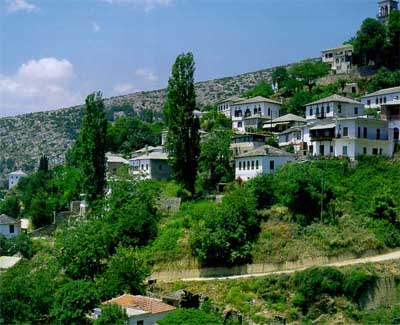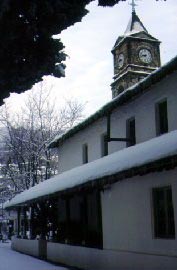|
|
Magnisia
 Volos,
(326 km. from Athens,
215 km from Salonica) is the capital and economic center of
the prefecture. Thanks to its privileged position at the foot
of Mt. Pelion on the Pagasetic Gulf, it is a good base for
enjoying the sea, wooded slopes and green valleys that
surround it. As for the derivation of the word
"Volos", which according to a Byzantine historian of
the 14th century was called "Golos", there are
several theories. The most widely accepted is that it
represents a corruption of the Mycenaean Iolkos.
Volos,
(326 km. from Athens,
215 km from Salonica) is the capital and economic center of
the prefecture. Thanks to its privileged position at the foot
of Mt. Pelion on the Pagasetic Gulf, it is a good base for
enjoying the sea, wooded slopes and green valleys that
surround it. As for the derivation of the word
"Volos", which according to a Byzantine historian of
the 14th century was called "Golos", there are
several theories. The most widely accepted is that it
represents a corruption of the Mycenaean Iolkos.
Founded in
the mid 19th century, modern Volos is a cheerful, lively town,
soundly laid out with pleasant, broad streets. The waterfront
is an ideal spot for a stroll. A modern coastal avenue
bustling with life, it is lined with pastry shops, cafes and
restaurants. From the suburb of Ano Volos, built up the slopes
of Pelion, the Pagasitic Gulf and the town below take on
another dimension.
Volos harbor
is particularly active. It is the main export center of
Thessaly and the scene of much commercial and passenger
traffic bound for the Sporades, the great ports of
Mediterranean, Syria and other Middle Eastern cities.
At the
Center of Greece
The city of
Volos is situated at the center of the Greek mainland, at an
approximately equal distance from the country's two main urban
centers, Athens and Salonica. Built at the innermost point of
the Pagasitic Gulf and at the foot of Mount Pelion, it is the
only outlet towards the sea from Thessaly, the country's
largest agricultural region.
The greater
Volos conurbation has a population of 150,000 and includes the
Municipality of Volos with 90,000 inhabitants, the
municipality of Nea Ionia with 50,000 inhabitants, the
municipality of Iolkos as well as smaller suburban
communities. From a population of 4,887 in 1881, when Thessaly
was annexed to the Greek state, Volos has increased its size
twenty-fold within one century.
A
combination of the knowledge and skills of the craftsmen of
Mt. Pelion, the labour force of Thessaly and investment from
the major centres of the Greek diaspora has enabled the city
to develop into an important industrial centre with the third
largest port in the country. The economy of the city is based
on manufacturing, trade, services and tourism.
Volos is
developing into a dynamic European city with a new and modern
university, an active cultural life and varied oppurtunities
for leisure and entertainment.
 Pelion,
land of the legendary Centaurs, the site chosen by the ancient
gods for their weddings and celebrations, rises in lush
magnificence to the northeast of Volos. It was here that the
centaur Chiron, the wise teacher of demigods and heroes, gave
his pupils daily instruction in the proper care of body and
soul. Here, as well, the first beauty contest took place
between Thetis and Eris. Many-leaved Pelion was an inspiration
to Homer, Pindar, and Euripides but also to the modern popular
muse who sung of the unquenchable desire of the Greek people
for freedom. Pelion,
land of the legendary Centaurs, the site chosen by the ancient
gods for their weddings and celebrations, rises in lush
magnificence to the northeast of Volos. It was here that the
centaur Chiron, the wise teacher of demigods and heroes, gave
his pupils daily instruction in the proper care of body and
soul. Here, as well, the first beauty contest took place
between Thetis and Eris. Many-leaved Pelion was an inspiration
to Homer, Pindar, and Euripides but also to the modern popular
muse who sung of the unquenchable desire of the Greek people
for freedom.
The highest
peaks of Pelion (Pliasidi 1548 m. and Pourianos Stavros 1610
m.) are in the northern part of the range. Its inaccessible
eastern flank, with the Aegean Sea stretching out into the
distance like a vast mirror, comes to an abrupt end in the
sea, creating wildly beautiful rocky shores. Conversely, the
tranquil, calm coast of the western flank on the Pagasetic
Gulf is much easier to reach and encourages shipping activity.
Pelion's
picturesque villages, sometimes clinging to wooded slopes or
perched on steep bluffs, sometimes hidden away in verdant
ravines, are so much a part of the scenery that, seen from a
distance they create the impression of having "sprouted
up"; along wiith the trees.
The
distinctive traditional architecture of the old houses with
their narrow windows and decorated walls, stone stairways and
roofs of grey or greeny slate; the Byzantine churches with
wonderful wall paintings and icon screens; the winding cobbled
paths, sculpted fountains, courtyards redolent of basil and
gardenia; squares paved with huge flag stones where the
cheeful bubbling of a little brook is never absent -are all
typical features of a Pelion village. |